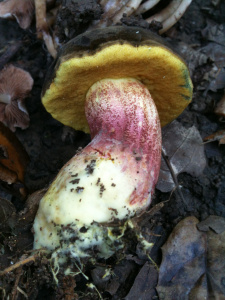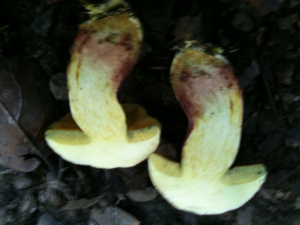Certain insects in the true bug order are specialized to only feed on plant sap, including all aphids (Aphidae) and scales (Coccidae), and most of the planthoppers, leafhoppers, froghoppers, and cicadas (Hemiptera:Auchenorrhyncha aka Homoptera). These insects have syringe-like mouthparts to pierce the sap and/or water-conducting vessels of leaves, veins, stems, and fruits. Their adaptation to their extremely watery diet has also given rise to a very long intestinal tract with which they can absorb most of the nutrients of the sap before it passes out. But this still isn’t enough to absorb the sap’s sugars and other nutrients completely, so their frass (insect excrement) is very sweet.

A) shows an aphid piercing plant tissue with its syringe-like mouthpart B) shows how this stylet pierces a single cell (in this case making it ideal for sampling cell contents for an experiment by a plant physiologist) Credit: http://5e.plantphys.net/article.php?ch=t&id=136
This sugar-rich exudation of these insects is called “honeydew” or formerly, “Indian honey.” You may have noticed this phenomenon if you’ve parked your car under a tree infested with aphids, leaving the car and pavement below covered in a sticky clear film. It can also be noted on trees that have sooty mold growing on their lower leaves, often to the point of blackening them almost completely. The sooty mold grows on the honeydew medium. Honeydew is produced by very many species of insects on many species of plants, but is produced in most abundance by Aphids on trees.
[As an interesting aside, many species of ants eat the honeydew of sap-feeders who receive in exchange protection by the ants.]
Honeydew was one of the few sugary foods known to the American Indians. Others were of course honey, and in some deserts of the US southwest, honeypot ants, which have specialized workers that fill their abdomens with a sugary solution to form a sort of food storage to make it through lean times. However, honey was very limited in supply until the introduction of the European honey bee since native bees produce very little honey (Essig 1931). And honeypot ants are quite limited in distribution and take extensive digging to collect a small amount of honeypots.
So effectively, honeydew was the only sweet food known to California Indians, and was therefore highly prized and collected with zeal.
Many different tribes of Indians used honeydew as a edible treat, and had various methods of collecting this nectar:
– In arid regions, honeydew is especially abundant on willows (Salix) growing along streams and on and under many shrubs, where it dried, adhered, and was collected (Essig 1931).
– In southeastern California, the Tübatulabal and Paiute collected honeydew deposited by aphids on reed or cane (Jacknis 2004).
– The Paiute collected honeydew on reed (Phragmites) by beating the dried honeydew into a basket, making it into a ball which they later softened by a fire and ate like candy (Jacknis 2004).
– The Tübatulabal cut, flayed, and dried common reed [Phragmites australis (Cav.) Steudel], beat off honeydew crystals (onto a hide or the like), winnowed out the debris, and cooked it into a stiff dough with cold water (Smith 1978, Jacknis 2004). When this dough dried, it formed a hard loaf from which lumps were broken off to eat with chia (Salvia columbariae Benth.) or acorn and piñon pine (Pinus edulis Engelm.) seed gruel (Smith 1978, Jacknis 2004).
– The Yavapai and Papago picked and washed off honeydew from cane and willow, boiled it and allowed it to congeal into a sweet whitish loaf (Gifford 1936).
– Honeydew was especially abundant on the leaves and young stems of a common species of willow in the Yavapai territory on Date Creek (Gifford 1936). The branches with honeydew were broken off and stirred into water to make a refreshing drink (Gifford 1936).
– Honeydew was stored by the Paiute using a special shallow basket made of tule (Sutton 1995).
– The mealy plum aphid, Hyalopterus pruni (Geoffroy), although only introduced around 1879 from the Mediterranean region, was one species whose honeydew was eaten by the Indians (Heizer and Elsasser 1980).
The California Bay Laurel is one very common local species in the Bay Area that is often covered with aphid honeydew. Its leaves are edible (and very flavorful), so it has potential as a source of collecting local honeydew. In the right season, I will try to dry branches with a fresh layer of honeydew to beat off, or perhaps dip into water to dissolve it.
REFERENCES
Essig, E.O. 1931. A history of entomology. The Macmillan Company, New York, NY.
Gifford, E.W. 1936. Northeastern and western Yavapai. University of California Publications in American Archaeology and Ethnology 34(4):268.
Heizer, R.F. and A.B. Elsasser. 1980. The natural world of California Indians. University of California Press, Berkeley, CA.
Jacknis, I. 2004. Notes toward a culinary anthropology of Native California. In Food in California Indian culture. ed. Jacknis, I. Phoebe Apperson Hearst Museum of Anthropology, Berkeley, CA.
Smith, C.R. 1978. Tubatulabal. In Handbook of North American Indians Vol. 8: California, eds. W.C. Sturtevant and R.F. Heizer, p. 444. Smithsonian Institution, Washington, DC.








